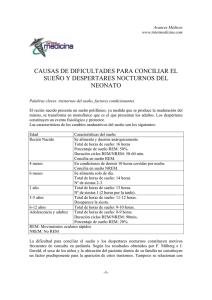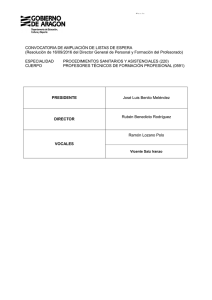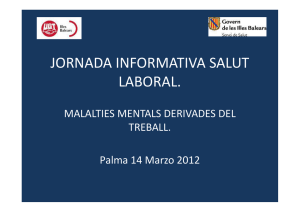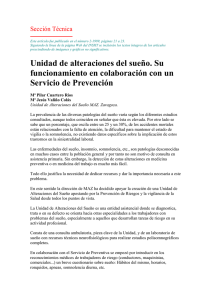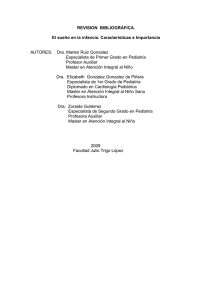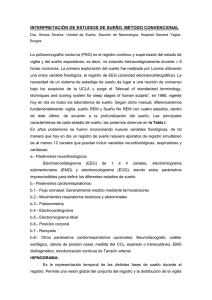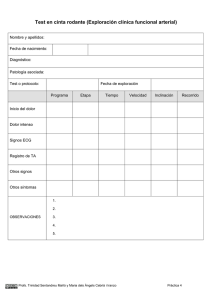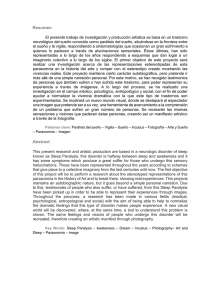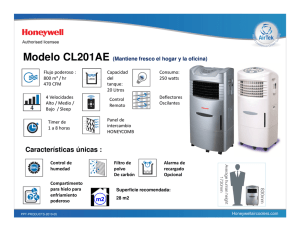DR. GAIG_Parasomnias REM
Anuncio
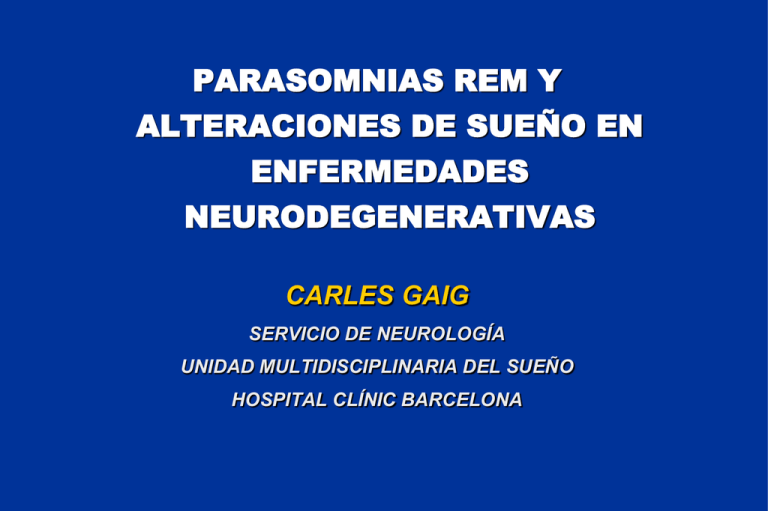
PARASOMNIAS REM Y ALTERACIONES DE SUEÑO EN ENFERMEDADES NEURODEGENERATIVAS CARLES GAIG SERVICIO DE NEUROLOGÍA UNIDAD MULTIDISCIPLINARIA DEL SUEÑO HOSPITAL CLÍNIC BARCELONA Dado el carácter y la finalidad exclusivamente docente y eminentemente ilustrativa de las explicaciones dadas el curso mediante esta presentación, el autor se acoge al articulo 32 de la Ley de propiedad intelectual vigente respecto al uso parcial de obras ajenas como imágenes, gráficos u otro material contenido en las diferentes diapositivas Totas las imágenes presentadas se incluyen como citas necesarias para ilustrar las explicaciones de esta clase Trastorno de conducta durante el sueño REM Disfunción del sueño REM: Pesadillas Conductas anormales Perdida de la atonía muscular del sueño REM TCSR: Pesadillas Precede a una enfermedad neurológica Asocia a una enfermedad neurológica Conductas agresivas Tratamiento con clonacepam Aprendemos sobre el sueño REM TCSR: Pesadillas y conductas anormales Most frequent unpleasant dreams Most frequent abnormal behaviors: Attacked by someone: 39-84% VOCALIZATIONS: Arguing with someone: 36-59% Shouting: 79-89% Chased by someone: 36-53% Laughing: 48-61% Falling from a cliff: 30-48% Crying: 42-52% Attacked by animals: 27-42% Unpleasant dream recall: 65-92% Talking: 90-96% Swearing: 27-33% Singing: 13-17% BEHAVIORS Punching: 65-83% Kicking: 57-78% Punch the bedside table: 43% Patients injured: 13-56% Bed partners injured: 6-23% Iranzo et al., Sleep Med Rev 2009 Falling out of bed: 38-82% Bite: 8% Sit on the bed: 8% / Walk outside the bed: 3% Self-awareness of behaviors: 24-54% LOC-A1 ROC-A2 C3-A2 C4-A1 O1-A2 O2-A1 Chin L Bic R Bic 1 sec LAT RAT Nasal Thor EKG REM normal B LOC-A1 ROC-A2 C3-A2 C4-A1 O1-A2 O2-A1 Chin Actividad muscular tónica excesiva L Bic R Bic 1 sec LAT RAT Nasal Thor EKG Actividad muscular fásica excesiva TCSREMB FORMAS DE TCSR 1) Idiopática (>80% Hombres; > 50 años) 2) Secundaria: Enfermedades neurodegenerativas: EP, DCLewy, AMS. TCSR CRONICO Otras enfermedades neurológicas: - Narcolepsia. - Lesiones focales tronco encefálico (ictus, tumor, EM). - Encefalitis límbica asociada a anticuerpos LGI1. Fármacos: antidepresivos (ISRS, ISNR, ADT), Beta-bloqueantes. TCSR AGUDO Olson Brain et al., 2000; Gagnon et al., Ann Neurol 2006; Iranzo et al Lancet Neurol 2006 TCSR Y ENFERMEDADES NEURODEGENERATIVAS a-sinucleinopatías TCSR EP 30-60% AMS >90% DCLewy 75-85% Taupatías E.Alz. 0.5-2% DLFT 0% DCB 0,1% PSP 15-30% Boeve et al., Brain 2007; Iranzo et al., Sleep Med Rev 2009 ¿TCSR “IDIOPÁTICO” ? Muchos pacientes con TCSR idiopático desarrollan una enfermedad neurológica. Seguimiento medio (años) Conversión (%) EP (n) DC Lewy (n) AMS (n) DCog. Leve (n) Schenck 1996 (n=29) 4 38 14 ? ? ? Iranzo 2006 (n=44) 5 45 9 6 1 4 Postuma 2009 (n=93) 5 28 14 11 1 ? El TCSR es un síntoma premotor – “preclínico” de una enfermedad neurodegeneretiva ¿TCSR “IDIOPÁTICO” ? El TCSR es un síntoma premotor – “preclínico” de una enfermedad neurodegeneretiva Seguimiento medio (años) Conversión (%) EP (n) DC Lewy (n) AMS (n) DCog. Leve (n) Schenck 2003 (n=29) 8 65 19 ? ? ? Iranzo 2013 (n=44) 12 82 16 14 1 5 Intervalo entre el inicio del TCSR y la enf. Neurológica: 10-11 años. Intervalo entre el diagnóstico de TCSR y la enf neurológica: 4-5 años. Edad al inicio de la enf.: 74 años. Iranzo et al., Lancet Neurol 2006; Iranzo et al., Lancet Neurol 2013 ¿TCSR “IDIOPÁTICO” ? TCSR precede a los síntomas clásicos de la enfermedad: Enfermedad de Parkinson……….............20-50% Demencia con cuerpos de Lewy….............90% Atrofia multisistémica…………….............50% Iranzo et al., Sleep Med Rev 2009 ¿TCSR “IDIOPÁTICO” ? Síntomas no motores típicos de la EP Hiposmia Alteraciones neuropsicológicas Alteraciones pruebas de imagen típicas de la EP DAT SPECT reducido. Hiperecogenicidad de la sustancia negra Escintigrafia cardiaca 123I-MBIG reducida Boeve et al., Brain 2007; Iranzo et al., Sleep Med Rev 2009 ¿TCSR “IDIOPÁTICO” ? Clinical symptoms Parkinsonism Neurone function/loss RBD Diagnosis PD DLB MSA Time 43 IRBD patients. Baseline evaluation: DAT SPECT, Transcranial Sonography Follow-up evaluation (2,5 year) “8/27 (30%) subjects with abnormal neuroimaging at baseline developed a neurological disorder” “None of the 15 participants with normal DAT SPECT or echogenicity developed a neurological syndrome during follow-up” FISIOPATOLOGÍA DEL TCSR Modelos animales de TCSR: Lesiones bilaterales del tegmento pontino (complejo ceruleus / subceruleus) FISIOPATOLOGÍA DEL TCSR TCSR secundario a lesiones focales del tronco encefálico (Tumorales, Vasculares, Desmielinizantes): ¡Lesiones en el tegmentum mesencefálico y pontino! Tippmann-Peiker et al., Neurology 2006 Boeve et al., Brain 2007 FISIOPATOLOGÍA DEL TCSR Estudios de neuroimagen Áreas REM-off: Sust. gris ventral-lat. periacueduct. (vIPAG) Sust. gris periacueduct (PAG) Tegmento pontino lateral (LPT) Áreas REM-on: N. preceruleus (PC) N. sublaterodorsal (SLD) Locus ceurleus (LC). N. Pedunculo-pontino (PPN). FISIOPATOLOGÍA DEL TCSR E.Alz PSP Hipoccampus +++ + + ++ DLFT EP AMS DCLewy Hauw et al., 1991 +++ Cortex Frontal Temporal ++ Parietal ++ +++ + +++ + Insular /cingular ++/+++ Caudate + Pallidum +++ Thalamus +/- N.Meynert ++ ++ S.Nigra + ++ Locus ceruleus + ++ +++ + +/- + +++ +/- +++ +++ +++ ++ N. Pont/medulla ++ +++ ++ N. Tractus solitarius ++ +++ ++ Estadio 2 de Braak “Lesions in caudal raphe nuclei, gigantocellular reticular nucleus, and coeruleus–subcoeruleus complex” Braak et al., Neurobiol Aging 2003 Diagnóstico del TCSR Historia clínica: Sueños desagradables Con la pareja del paciente Conductas vigorosas ¿Su sueña mucho? Polisomnográfia con registro EMG y vídeo Pérdida atonía muscular en el sueño REM Conductas anormales durante el sueño REM EOG EEG EMG Nasal Oral Thoracic Abdominal LTA RTA Apnea TCSR: Diagnóstico diferencial Sleep 2005;28(2):203-206 “Periodic Limb Movement Disorder” Parasomnia NREM Crisis epilépticas nocturnas Gagnon et al., Ann Neurol 2006; Iranzo et al., Sleep Med Rev 2009 TCSR: Tratamiento Clonazepam 0,5-1 mg antes de acostarse (dosis máxima 4 mg) Disminuye la frecuencia y gravedad de las pesadillas y conductas anormales. Reduce la actividad muscular fásica excesiva però NO la tónica. NO existen estudios doble ciego randomizados con placebo, pero efectivo. Otras benzodiacepinas (diacepam, loracepam) son infectivas. Efectos secundarios: Somnolencia, Puede agravar SAOS, problemas de memoria... Clonacepam INEFECTIVO en un 10% de los casos: Melatonina (4-12 mg/noche)? Medidas de Protección: Apartar mesilla de noche, colchón en el suelo. Otros trastornos de sueño y enfermedades neurodegenerativas SOMNOLENCIA DIURNA EXCESIVA (SDE) Y EP SDE: 15-59% de los pacientes con EP. FACTORES ASOCIADOS A LA ENFERMEDAD Medicación antiparkinsoniana (Ag DA, l-dopa,...). Otros fármacos con efecto sedante (neurolépticos, hipnóticos, antidepresivos...). Mala calidad sueño nocturno (Baja eficiencia y sueño fragmentado).). FACTORES COMORBIDOS Y PATOLOGÍA DE SUEÑO Depresión. Síndrome de las apneas obstructivas del sueño. HIPERSOMNIA CENTRAL Factor Mov Disord 1990; Tandberg Mov Disord 1999; Tan Neurology 2002; Hobson JAMA 2002; Brodsky Mov Disord 2003 ESTRIDOR Y ATROFIA MULTISISTÉMICA Estridor durante el sueño: 13-42% de los pacientes con MSA ESTRIDOR Y ATROFIA MULTISISTÉMICA Obstrucción de la vía aérea en la laringe durante la inspiración (Sueño >>>Vigilia) Fisiopatología en la MSA? Parálisis ABD y/o hipertonía ADD? Puede ser el primer síntoma de la AMS. No se asocia a la gravedad, duración o subtipo de MSA El paciente no es consciente del ruido, Apneas durante el sueño, Disnea, Estridor en vigilia, Insuficiencia respiratoria. Muerte súbita durante el sueño. Marcador de corta supervivencia. TRATAMIENTO DEL ESTRIDOR Traqueotomía Cordectomía - Efectiva - By-pass de las cuerdas vocales - Invasivo - Frecuentemente rechazado - Complicaciones locales Toxina botulínica en aductores CPAP - No invasivo - Abre la glotis que estaba cerrada - Elimina el estridor nocturno (5-10 cm H20) - Incrementa la superviviencia Iranzo et al., Lancet 2000; Iranzo et al., Neurology 2004 SUMARIO Los trastornos de sueño son frecuentes en las enfermedades neurodegenerativas. El TCSREM es una parasomnia que ocurre con frecuencia en la EP, DC Lewy i AMS (Sinucleinopatías). El TCSREM idiopático con frecuencia antecede una enfermedad neurodegenerativa (Sinucleinopatías). La SDE es frecuente en enfermedades neurodegenerativas como la EP, y tiene un origen multifactorial. El Estridor en el contexto de una enfermedad neurodegenerativa es característico de una AMS Bibliografía Iranzo A, Tolosa E, Gelpi E et al. Neurodegenerative disease status and post-mortem pathology in idiopathic rapid-eye-movement sleep behaviour disorder: an observational cohort study. Lancet Neurol. 2013 May;12(5):443-53. Scherfler C, Frauscher B, Schocke Met al. SINBAR (Sleep Innsbruck Barcelona) Group. White and gray matter abnormalities in idiopathic rapid eye movement sleep behavior disorder: a diffusion-tensor imaging and voxel-based morphometry study. Ann Neurol. 2011 Feb;69(2):400-7. Iranzo A, Lomeña F, Stockner H, et al; Sleep Innsbruck Barcelona (SINBAR) group. Decreased striatal dopamine transporter uptake and substantia nigra hyperechogenicity as risk markers of synucleinopathy in patients with idiopathic rapid-eye-movement sleep behaviour disorder: a prospective study [corrected]. Lancet Neurol. 2010 Nov;9(11):1070-7. Postuma RB, Gagnon JF, Vendette M, et al. Quantifying the risk of neurodegenerative disease in idiopathic REM sleep behavior disorder. Neurology. 2009 Apr 14;72(15):1296-300. Iranzo A, Santamaria J, Tolosa E. The clinical and pathophysiological relevance of REM sleep behavior disorder in neurodegenerative diseases. Sleep Med Rev. 2009 Dec;13(6):385-401. Arnulf I, Nielsen J, Lohmann E, et al. Rapid eye movement sleep disturbances in Huntington disease. Arch Neurol. 2008 Apr;65(4):482-8. Boeve BF, Silber MH, Saper CB, et al. Pathophysiology of REM sleep behaviour disorder and relevance to neurodegenerative disease. Brain. 2007 Nov;130(Pt 11):277088. Tippmann-Peikert M, Boeve BF, Keegan BM. REM sleep behavior disorder initiated by acute brainstem multiple sclerosis. Neurology. 2006 Apr 25;66(8):1277-9. Gagnon JF, Postuma RB, Mazza S et al. Rapid-eye-movement sleep behaviour disorder and neurodegenerative diseases. Lancet Neurol. 2006 May;5(5):424-32. Iranzo A, Molinuevo JL, Santamaría J et al. Rapid-eye-movement sleep behaviour disorder as an early marker for a neurodegenerative disorder: a descriptive study. Lancet Neurol. 2006 Jul;5(7):572-7. Kumru H, Santamaria J, Tolosa E et al. Rapid eye movement sleep behavior disorder in parkinsonism with parkin mutations. Ann Neurol. 2004 Oct;56(4):599-603. Iranzo A, Muñoz E, Santamaria J, et al. REM sleep behavior disorder and vocal cord paralysis in Machado-Joseph disease. Mov Disord. 2003 Oct;18(10):1179-83. Olson EJ, Boeve BF, Silber MH. Rapid eye movement sleep behaviour disorder: demographic, clinical and laboratory findings in 93 cases. Brain. 2000 Feb;123 (Pt 2):331-9. Schenck CH, Bundlie SR, Mahowald MW. Delayed emergence of a parkinsonian disorder in 38% of 29 older men initially diagnosed with idiopathic rapid eye movement sleep behaviour disorder. Neurology. 1996 Feb;46(2):388-93.
